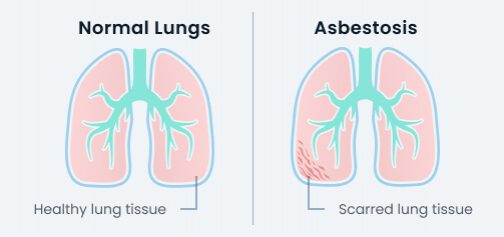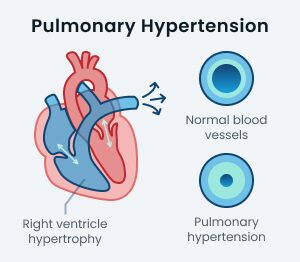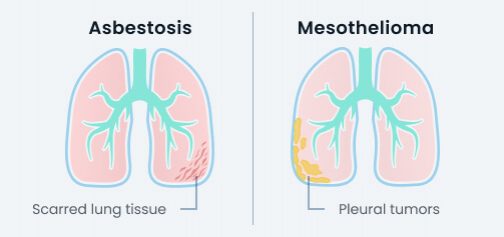Asbestosis
Asbestosis causes over 3,000 deaths globally each year. The disease forms scar tissue in the lungs, which leads to chronic respiratory symptoms and decreased oxygen levels. Treatment of symptoms allows patients to live for many years with the disease. However, asbestosis disease is irreversible, with no cure.
What Is Asbestosis?
Asbestosis disease is an illness characterized by scarring in the lungs due to asbestos exposure. It is classified as a type of pulmonary fibrosis and not a form of cancer. Physicians also refer to this disease as interstitial pneumonitis.
The development of scar tissue causes stiffness and restricts your lungs from expanding. Asbestos fibers can also become trapped in the alveoli, or air sacs, of the lungs, preventing the absorption of oxygen into the bloodstream.
A majority of diagnosed cases originate from workplace exposure. Asbestos-containing materials were prevalent in mining or manufacturing industries before their restriction in the mid-1970s.
Asbestosis is an incurable disease that causes chronic respiratory issues, and the damage to the lungs is irreversible. Treatment can slow the progression of the disease and alleviate symptoms to improve breathing. However, asbestosis disease also signifies an increased risk of developing mesothelioma cancer in the future.
How Long Can You Live with Asbestosis?
Symptoms vary in severity based on the amount and duration of asbestos inhalation, but early signs of the disease may not develop for decades after initial exposure.
The average life expectancy of mesothelioma patients is around 12 months. Conversely, asbestosis has a much better survival rate. Many patients with asbestosis can live for decades after symptoms appear, but as the disease progresses, their quality of life often decreases.
Over 90,000 people globally die from asbestos-related diseases each year. The World Health Organization estimates 125 million people worldwide remain at risk of occupational asbestos exposure.
Causes and Risk Factors of Asbestosis
Asbestos is the only cause of asbestosis disease. Inhaling asbestos fibers released from the destruction or degradation of asbestos-containing materials causes the small needlelike particles to become trapped in the lungs.
As your body’s immune system tries to eliminate the asbestos fibers, it causes chronic inflammation, which leads to the formation of scar tissue.
White blood cells cannot eliminate the asbestos fibers, and scar tissue forms around the sites of inflammation, blocking passages in the alveoli.
Scar tissue also interferes with the fibroblast cells responsible for producing collagen, which forms the extracellular matrix that allows your lungs to expand and contract.
As scar tissue accumulates, the lungs become more rigid, restricting oxygen from entering the bloodstream.

How Long Does It Take to Develop Asbestosis?
Some patients may begin experiencing symptoms after 10 years, but the effects of asbestosis disease may not develop for up to 40 years after initial exposure. On average, symptoms appear between 20 and 30 years after exposure to asbestos.
For those who sustained more severe exposure, such as asbestos miners or demolition workers, the latency period is between 12 and 20 years. However, in some studies, asbestosis developed in patients after only five to nine years of significant exposure.
Who Is Most at Risk?
The groups at the highest risk for asbestosis disease are blue-collar workers in the construction, engineering, automotive and shipbuilding industries. These professions exposed employees to asbestos-containing materials until the 1980s.
First responders and demolition cleanup crews are also at risk of asbestosis when exposed to large amounts of debris, such as in the aftermath of the 9/11 World Trade Center attacks.
- Total concentration and amount of asbestos
- Length of exposure or repeated exposures
- Size and type of asbestos fibers
- History of lung disease or chronic health conditions
- History of smoking or previous lung damage
- Genetic predisposition or DNA mutations that increase risk
Asbestosis Symptoms
The damage caused to the air sacs in the lungs by years of scar tissue development affects breathing ability and oxygen intake. Symptoms of asbestosis disease are similar to other chronic respiratory illnesses, such as chronic obstructive pulmonary disease or COPD.
- Persistent dry cough
- Shortness of breath
- Chest tightness
- Pain with deep breaths
- Loss of appetite and weight loss
- Crackling sound in the lungs
An impaired ability of the lungs to expand, combined with lowered oxygen exchange in the blood, leads to pain, shortness of breath and general fatigue. A lack of energy and compromised breathing causes weight loss and poor nutrition from a decreased appetite.
Advanced Symptoms
Chronic levels of low oxygen produce other long-lasting adverse effects on the body. These symptoms indicate more severe issues of oxygen deprivation caused by asbestosis:

Pulmonary Hypertension: Contrary to systemic high blood pressure, pulmonary hypertension is the decreased ability of the heart to pump blood into the lungs. The constriction of pulmonary arteries due to scar tissue leads to increased pressure and a higher risk of coronary artery disease and congestive heart failure.

Clubbed Fingers and Toes: A sign of decreased oxygen reaching the extremities is the rounding and thickening, or clubbing, of the nails and nailbeds of fingers and toes. The tips of these extremities may become deformed due to a lack of oxygen. Because the damage caused by asbestosis is irreversible, these symptoms are likely to persist.
Diagnosing Asbestosis
Physicians will typically require a thorough medical history that involves a record of asbestos exposure when making a diagnosis of asbestosis. In addition to medical and exposure history, your doctor will order imaging tests and breathing tests to confirm the disease and determine the extent of lung damage.
- Grade 0: Scarring has occurred in the airways, or bronchioles, that lead to the alveoli.
- Grade 1: Scarring is present on more walls of the bronchioles and affects some alveoli.
- Grade 2: There is damage to most of the bronchioles and alveoli.
- Grade 3: Some alveoli are entirely damaged, and lung scarring is advanced.
- Grade 4: There is a honeycomb-like appearance throughout the lungs due to extensive scarring, and the alveoli function is severely compromised.
- Chest X-ray or CT Scan: These imaging tests can detect scar tissue and inform your provider if the damage is present in one or both lungs. CT scans visualize soft tissues with greater detail and can detect asbestosis in its earlier stages.
- Pulmonary Function Tests: PFTs measure how much air your lungs are using during inhalation and exhalation. The patient blows into a small device called a spirometer that gauges airflow.
- Bronchoscopy: In this bedside procedure, a doctor uses a small camera attached to a thin and flexible guide tube passed through the nose or mouth into the lungs. This exam looks for damage in the airways and can retrieve fluid or tissue samples for a biopsy.
- Thoracentesis: In some cases, asbestosis causes the buildup of fluid in the tissues surrounding the lungs. This outpatient procedure uses a long needle inserted between the ribs to drain fluid and improve breathing. Your doctor can also send the sample to a lab for testing.
If you have a known history of exposure to asbestos and are having respiratory difficulties, inform your primary care physician, who will likely refer you to a pulmonologist.
A pulmonologist specializes in lung disease and will order the appropriate tests to confirm a diagnosis of an asbestos-related disease, such as asbestos-related lung cancer. Having the necessary information about your health background and current symptoms will save time and improve the accuracy of the exam
- A list of your current symptoms, with severity
- When your symptoms started
- Your entire work history and type of work performed
- The types of materials you worked with and the conditions involved
- Any previous treatments used for your current symptoms
- Smoking history and a history of chronic illness
- Previous medical records or imaging
Treating and Managing Asbestosis
Like other chronic illnesses, such as COPD or heart disease, asbestosis requires regular treatment to manage symptoms and slow progression of the disease. Pharmacological and surgical therapies cannot reverse lung damage, but they do work to make breathing efforts more effective.
Can Asbestosis Be Cured?
There is no cure for asbestosis disease. Asbestosis treatments are palliative and focus on reducing the severity of symptoms and improving overall breathing ability. More frequent treatment may be required in older patients as the disease progresses with age.
Medications
Doctors may prescribe oral medications and breathing treatments to relieve the effects of asbestosis. Some of these medications are available over the counter, while others require a visit to a treatment center where a respiratory specialist administers the drug.
- Bronchodilators: Typically known as inhalers, these medications relax the muscles in the airway and provide immediate relief from shortness of breath. Usual examples are Ventolin, Proventil, Xopenex and Serevent.
- Anti-Inflammatories: Corticosteroids are the standard choice for anti-inflammatory medications. Combined with other immunosuppressants, these medications decrease the inflammatory immune response but do not aid with the damage caused by scarring.
- Expectorants: Guaifenesin (Mucinex) is part of a class of drugs that thin secretions and improve the effects of coughing. Increasing water intake also helps to break apart mucous and open airways.
- Oxygen: As scarring reduces the lungs’ ability to intake oxygen, supplemental methods may be necessary. A portable oxygen tank that feeds oxygen through two cannulas placed under the nostrils is a popular option for patients with low oxygen levels.
Surgery
Some diagnostic surgical procedures, such as thoracentesis, are also used as a palliative option. Pleural effusion, the buildup of fluid around the lungs, is drained through thoracentesis, allowing the lungs to work more effectively.
Pleural effusions that are left untreated may lead to pleural thickening, which is stiffness of the lining surrounding the lungs. This condition exacerbates chest pain and difficulty breathing.
In the most advanced stage of asbestosis, a physician may recommend a lung transplant. Surgeons remove either one or both lungs from a deceased donor and transplant them into the asbestosis patient, replacing the scarred and diseased lungs.
Transplantation is an extensive surgery and can have many complications, such as tissue rejection. The procedure is considered a last resort, and follow-up care, including antirejection medications, is typically for life.
Managing Symptoms
There are steps patients can take to limit the progression of asbestosis and improve the effectiveness of treatments. For example, patients diagnosed with asbestosis should stop smoking as soon as possible.
Some treatment centers offer pulmonary rehabilitation, such as exercise programs. These are designed to increase stamina and energy levels, which can be impacted by chronic lung conditions.
Maintaining a healthy diet and proper nutrition will preserve lung health and sustain healthy lung tissue longer. Combined with adequate sleep and exercise, healthy lifestyle changes can maximize the efficiency of your lungs.
Some patients seek complementary and alternative medicine to assist with breathing and symptom management. Therapies such as yoga, acupuncture and meditation can help control breathing and reduce pain. However, patients should discuss the use of these treatments with a physician to ensure they do not interfere with primary therapy.
Patients with pulmonary fibrosis and other chronic lung diseases are at a higher risk of respiratory infections, such as bronchitis and pneumonia. Speak with your physician about vaccinations for flu and pneumonia, as well as other ways to prevent disease. Patients with allergies will also want to avoid areas with a high pollen count or pollution.
Asbestosis vs. Mesothelioma

Mesothelioma and asbestosis are both caused by asbestos exposure but differ in several meaningful ways. The most crucial distinction is that mesothelioma cancer is malignant. Asbestosis is not a type of cancer.
The primary characteristic of asbestosis disease is pervasive scarring across the lungs and airways. Asbestosis is one of many types of pulmonary fibrosis. Asbestosis treatment is not usually as aggressive as mesothelioma treatment options.
Mesothelioma cancer involves the formation of tumors within the lining of the lungs, abdomen or heart and is treated similarly to lung cancer, often with chemotherapy and radiation.
Symptoms are similar in both conditions and can take several decades to manifest. Asbestosis is somewhat easier to diagnose through imaging scans and medical history. Mesothelioma requires a biopsy for confirmation. Occupational asbestos exposure is the leading cause in both conditions, which causes lifelong, irreversible compromise to respiratory function.



